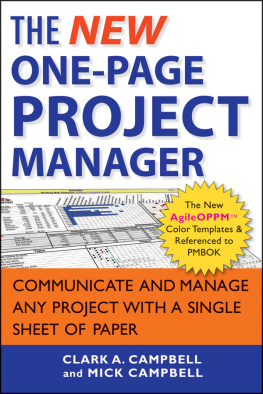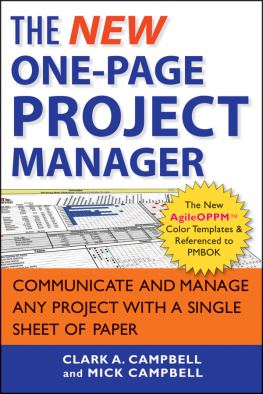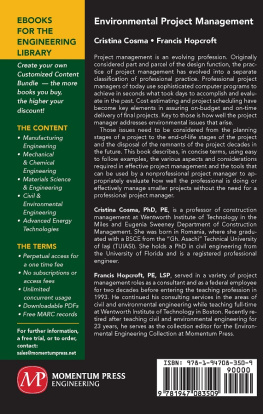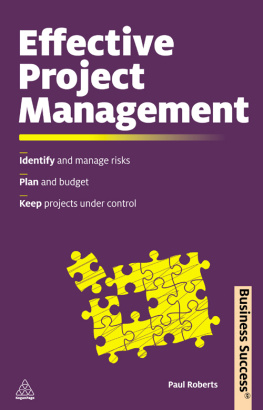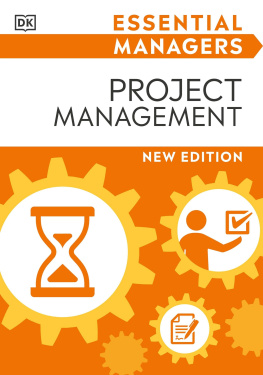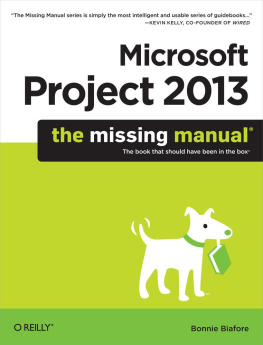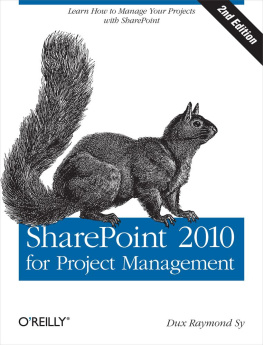
Praise for The New One-Page Project Manager
The New One-Page Project Manager is an essential part of my executive toolkit. OPPMs communicate a project's plan and then communicate progressive performance to that plan in a complete yet efficient way, thereby increasing the visibility and collaboration so vital for successful project management.
Michael O. Leavitt, Chairman, Leavitt Partners; Secretary,
United States Department of Health and Human Services (20052009);
Administrator, United States Environmental Protection Agency (20032005);
Governor of Utah (19922003)
Creating clarity from ambiguity, while organizing complex interrelated processes, lies at the heart of outstanding project management. The New One-Page Project Manager is a tremendous tool to assist in achieving that goal.
Chris Liddell, Former CFO,
Microsoft and Vice Chairman and Chief Financial Officer,
General Motors
As the CEO of Deloitte, I had oversight of countless projects, both at Deloitte and at our clients. Successful change initiatives require clear vision, strong leadership, meaningful milestones, focused execution, and clear accountability. Clark Campbell, through The New One-Page Project Manager, has successfully integrated those critical success factors in one readable page. The difference between projects that succeed and those labeled as disappointments is always made in the execution. The OPPM can be an effective enabler of strong project management, significantly increasing the likelihood of success.
James H. Quigley, CEO Emeritus of Deloitte
While at initial glance this book may appear to be simply about developing a dashboard for tracking an important project, it soon becomes clear that it is much more than that. The approach outlined by Clark Campbell, an experienced and accomplished project leader, provides a proven process for project management that significantly improves the chances that the project will be completed on time, on budget, and on target for its intended purposes. Furthermore, it provides a straightforward yet compelling set of steps to ensure that those with the ability and responsibility to achieve the desired results are supported, guided, and focused in their efforts to do so. This approach will prove especially beneficial to students and practitioners who want to learn and apply the skills and tools of effective project leadership.
Steven C. Wheelwright, PhD, Baker Foundation Professor,
Senior Associate Dean, Director of Publications Activities,
Harvard Business School, Harvard University
Impressive in its simplicity, yet universal in its application, the One-Page Project Manager began assisting Chinese project managers in 2003, when Mr. Campbell first lectured in Beijing. OPPM is easy to learn and use, and is impressive in its clear capacity to communicate. It should be required reading for every manager who wants to improve project performance, accurately tell their story, and do it efficiently.
Jonathan H. Du, PhD, CEO and Chairman,
WiseChina Training Ltd., Beijing, China
Total Lean Management requires lean communication. OPPM is in very deeda lean communication tool. O.C. Tanner, a Shingo Prize winner, is among the top 3 percent of Lean companies in North America. Their distinctive combination of OPPM with Toyota's A3 report reveals a unique, continuous improvement, one that documents, in part, how they have executed their strategy to achieve market dominance and profitable growth.
Ross E. Robson, PhD, President DNR Lean LLC,
Strategic Founder and Executive Director of the Shingo Prize (retired)
Don't be fooled into thinking that OPPM is applicable only to monumental and product related tasks. OPPM is a way of organizing the way one thinks about tasks that lie ahead. It is a way to identify what goals are worth the investment of time and other resources, and then to describe them in simple and measurable terms. It is just as useful in building a winning little league team as it is in building a ball field. Once understood, OPPM is a tool useful for any task important enough to plan for.
Justice Michael J. Wilkins, Utah Supreme Court (retired)
This book is printed on acid-free paper. 
Cover image: Courtesy of Clark A. Campbell
Cover design: John Wiley & Sons, Inc.
Copyright 2013 by Clark Campbell and Mick Campbell. All rights reserved.
Published by John Wiley & Sons, Inc., Hoboken, New Jersey.
Published simultaneously in Canada.
No part of this publication may be reproduced, stored in a retrieval system, or transmitted in any form or by any means, electronic, mechanical, photocopying, recording, scanning, or otherwise, except as permitted under Section 107 or 108 of the 1976 United States Copyright Act, without either the prior written permission of the Publisher, or authorization through payment of the appropriate per-copy fee to the Copyright Clearance Center, 222 Rosewood Drive, Danvers, MA 01923, (978) 750-8400, fax (978) 646-8600, or on the web at www.copyright.com. Requests to the Publisher for permission should be addressed to the Permissions Department, John Wiley & Sons, Inc., 111 River Street, Hoboken, NJ 07030, (201) 748-6011, fax (201) 748-6008, or online at www.wiley.com/go/permissions.
Limit of Liability/Disclaimer of Warranty: While the publisher and author have used their best efforts in preparing this book, they make no representations or warranties with the respect to the accuracy or completeness of the contents of this book and specifically disclaim any implied warranties of merchantability or fitness for a particular purpose. No warranty may be created or extended by sales representatives or written sales materials. The advice and strategies contained herein may not be suitable for your situation. You should consult with a professional where appropriate. Neither the publisher nor the author shall be liable for damages arising herefrom.
For general information about our other products and services, please contact our Customer Care Department within the United States at (800) 762-2974, outside the United States at (317) 572-3993 or fax (317) 572-4002.
Wiley publishes in a variety of print and electronic formats and by print-on-demand. Some material included with standard print versions of this book may not be included in e-books or in print-on-demand. If this book refers to media such as a CD or DVD that is not included in the version you purchased, you may download this material at http://booksupport.wiley.com. For more information about Wiley products, visit www.wiley.com.
Library of Congress Cataloging-in-Publication Data:
Campbell, Clark A., 1949
The new one-page project manager : communicate and manage any project with a single sheet of paper / Clark A. Campbell and Mick Campbell.
p. cm.
Rev. ed. of: The one-page project manager. c2007.
Includes index.
ISBN 978-1-118-37837-3 (pbk); 978-1-118-46113-6 (ebk); ISBN 978-1-118-46115-0 (ebk); ISBN 978-1-118-46147-1 (ebk)
1. Project management. 2. Business report writing. I. Campbell, Mick, 1974- II. Campbell, Clark A., 1949- One-page project manager. III. Title.
HD69.P75C363 2013
658.404dc23
2012032709
To Tracy
Foreword
You have in your hands a book that is both a critical tool for, and a symbol of, our innovation economy.
Our twenty-first-century workplace is the scene of rapid, visible evolution. This rapid evolution means we are surrounded by projects. Some projects are huge, such as a new commercial airplane model. But the proliferation of projects is due more to an increase in small projects, such as implementing standardized processes in an operating room, a promotion campaign for a winery, or opening a new office for a growing business. There are many reasons the pace of change and the number of projects are increasing, but there is no doubt it is true, for the evidence is all around us.
Next page
